The roots of Alaró
Some controversy exists regarding to the origin of the name of Alaró, in past times called Hisn al'-rúm, as different authors don't seem to reach an agreement. On one hand, the etymological research of the word leads linguists Antoni Maria Alcover and Francesc de Borja Moll to the toponym of llurone – according to them, a word original from French- that after a latinization process evolved to the term Oloron and finally, changed to the present Alaró.
On the other hand, there is an Andalusian narration that apparently refutes this theory. Among the texts that recount the Arab occupation of the isles, geographer and historian Alzuhrî describes in the 12th century the resistance of Byzantines against Moors during the year 903, which takes place in a big fortress called Hisn al'-rúm or Hisn Alarum: the old Christians of the castle.
Al-Zuhrî (12th century) recounts the fall of Alaró castle
In this island there is a big fortress built in a high and barren place, peerless in the inhabited world; it is known with the name of Hisn Alarum. Mallorcan people tell that when the island was conquered in the period of Muhammad, Rum people grew strong during eight years and five months after the conquest. No one could do anything against them, until the lack of provisions forced them out. The fortress rises on the summit of a hard rock mountain, where there is a plentiful fountain
The village's first inhabitants
First traces of settlement roots in Alaró are found in the buildings of Talayotic Culture, corresponding in Mallorca to the Iron Age. This last period of prehistory ended with the Roman conquest in 123 BC. These settlements are characterized by the technique of stones that fit into each other without using any kind of mortar to join them. Their name comes from the term 'watch-point', as most of them where situated in defense or observation strategic points.
Talayots are also related to ceremonial or residential uses, as they share with other ancient constructions, the doorway orientated in relation to the rising of a significative star or constellation for the people of the time. Talayotic sites with different conservation values have been found in Alaró. Their traces are located in private properties, but as they have been declared as Cultural Interest Sites (BIC), they can be visited with a previous authorization. Spanish BIC is a juridic institution where cultural heritage can be registered and protected, the following archaeological sites where declared as BIC in 1966:
Es Picó y Son Palou
Set of two talayots, both from the Iron Age. The first one is preserved in good conditions although it appears covered with vegetation. This talayot of trapezoid floor plan, of 9m by 11m and 4.5m high, preserves the doorway with lintel orientated to the south, even though it shows fragmentations and has support problems. The interior of the talayot is blocked, not because of collapse, but rather because a wall was built to this end.
The second one, of circular floor plan, has only preserved the first row of stones and to the surprise of everyone, it has an electric post stuck in its interior.
S'Alcadena or es Claper des Gegant
This is a mountain oval talayot, of 8m of diameter and nearly 3m high, an irregular construction that is located isolated in a highland of Alcadena farmhouse. Its gate, orientated to the southwest, looks directly to the valley at its foot. One of its sides is almost unrecognizable because it is covered with stones that have been removed from the land beside for cultivating, which gives the talayot the popular name of Claper des Gegant -stony area of the giant. The chamber is blocked because of the collapse of the roof. The building shell is made of irregular stone blocks, scarcely retouched and roughly fixed between them, which means they were apparently extracted from the environs of the talayot and not excessively worked over.
Bànyols (Puig de s’Apit)
Circular floor plan talayot made of scarcely carved big stones fixed among them. One of these flagstones has 2.5m long by 1.4m high and at least 1.1m wide, a good example of the monumentality of these buildings. The talayot appears isolated and lonely, although is not possible to determine if it was originally in this situation as the land is parceled up and exploited. Sited on the eastern hillside of Puig de s'Apit, it has 11m of diameter and a present maximum height of 3.3m. There is no doorway and the collapse of the roof blocks the entrance to the chamber.
Can Cabrit o s’Era Vella
In this area, there are traces of a talayotic village. The most important figures are two structures of circular floor plan and two of quadrangular floor plan. Probably, if the area was excavated, similar floor plans would be found. Among the set, the best preserved is a talayot of rectangular floor plan of 10m by 11m. Traces of other buildings detached to the eastern and southern faces can be recognized. In a wide area surrounding this talayot, other monuments appear in an extremely ruined state.
On the Puig de Can Cabrit, traces of a second talayotic village have been located, from which the best conserved monument is a talayot of rectangular floor plan that has 10.40m by 11m of side and 2.2m of maximum height. No doorway to enter the chamber is distinguished as it is inaccessible due to the fallen roof. Detached to the western side, there is a third building and nearby, other prehistoric constructions in more advanced state of decay. A new figure can be appreciated in the southern end of the village: a talayot of circular floor plan of about 11m of diameter. It is very probable that both settlements formed only one village in the past.
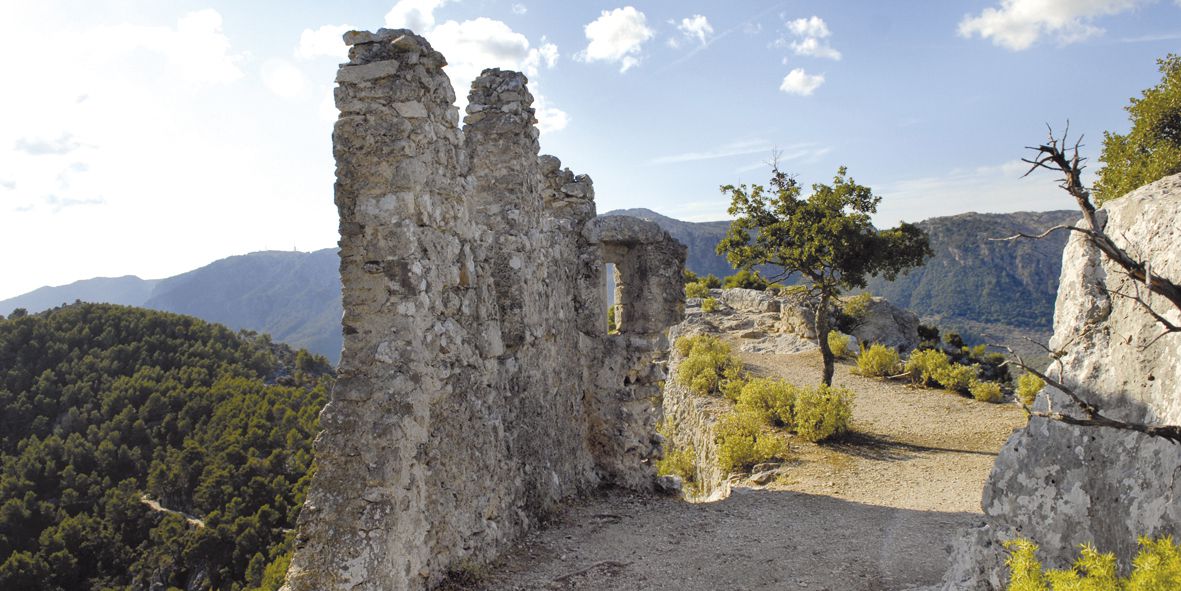
Barbarians and Byzantines
The occupation of Mallorca, and invariably of Alaró, has been constant. Alaró constituted an exceptional defensive position -for the elevation of the Serra de Tramuntana- that has safeguarded its changing over time population. We find testimony in the sites of Sa Bastida and Castell d'Alaró rock cliffs, which show us the echos of their old uses during the mid 4th and 5th centuries. They are the late-Roman defensive traces of the period.
After the fall of the Roman Empire, no elements have survived referencing the invasion and later Vandal settlement of the African kingdom of Genseric in the late 5th century. At the end of the 7th century, Moors conquered North Africa and in 707 their first landing in the island is documented, but it is not until 902-903 when the Moors conquer Mallorca. Surprisingly, the island already pertained to the Byzantine Empire orbit and payed tribute to Cordoba. This event was echoed by geographer Al-Zuhrî during the 12th century, who narrated how Moors subdued the fortress – and their Byzantine inhabitants- with eight years and a half of siege. One of Alaró's most significative elements, preserved from the Moorish period, is the original well and part of the canal layout -Mallorcan síquia- of the Qânat or Font de ses Artigues.
Conquest and Repopulation
The conquest of Mallorca by the Catalan troops of Jaume I the Conqueror was justified as a crusade against infidels, although the main reason, as in any assault or occupation, was basically economic. On the one hand, if the invasion ended successfully, wealth and lands for the king and the nobles participating increased, and obviously, their power and prestige too.
On the other hand, the conquest of the isles by the Moors turned the West Mediterranean into an insecure area, where the Christian ships were subdued to constant pirate attacks. So finally, merchants also benefited from the campaign as secure markets would be established in the area.
Even though the conquest was supported by the main Catalan prelates and magnates, other towns like Provence (France) and Liguria (Italy) also participated, as well as the cities of Tortosa, Tarragona and Barcelona, which after all, were the most affected by pirate looting.
The 5th of September of 1229, an impressive fleet of more than 155 ships, 800 knights and thousands of soldiers, organized and captained by Jaume I, set off from Catalonia to Mallorca. The 31st of December of 1229, the capital Medina Mayurqa falls and with her great part of the island's resistance.
King Jaume I did not try to take Castell d'Alaró until his second expedition, in 1231, due to the difficulties that entailed attacking the rocky castle. Actually, a guerrilla warfare that took until 1232 had already been initiated in the mountain areas. Once defeated the fortifications of Alaró, Felanitx and Capdepera, it could be said that Mallorca was totally conquered.
Legend was forging, Castell d'Alaró was considered of vital importance during numerous centuries: its proverbial unbeaten power secured to those that had it in their hands, the final resistance in case of new attacks against Mallorca were organized.
As a result of the conquest, Jaume I sealed the destiny of Mallorca with some acts that determined its history: the creation of a Kingdom with its own institutions, the Division -partition among the magnates, agreed before the attack and proportional to their military and financial contributions to the campaign-, the Repopulation -creation of towns with new settlers in territories gained to Moors- and christianization of the population left.
After the repartition of the island, Alaró became part of the district of Canarossa, ruled by the viscount of Bearn. When Jaume I died, he left a will that fixed the repartition of the kingdom among his sons: consequently, the Kingdom of Mallorca passed to Jaume II. In 1285 Alfons III of Aragon, the magnate's nephew, wanted to take the island and initiated an attack directing his father's troops. He had almost achieved his purpose, after receiving a loyalty oath from great part of the settlers, when he marched to Castell d'Alaró. At this point history and legend meet as centuries have blurred if the details of the tale belong to reality or to fiction.
At his arrival to the watch-point, Alfons d'Aragó bumped with the resistance of Guillem Cabrit and Guillem Bassa that betted the castle in name of the king of Mallorca and did not surrender to the authority of the new monarch. Finally, the fortress was subdued and Cabrit and Bassa were captured and roasted over embers in the square of Los Damunt.
The legend of Cabrit and Bassa
In 1285 the army of Pere el Gran, captained by his son Alfons III el Franc, set off from Catalan coasts. Once in Mallorca, the young king lanced to the conquest after being told his father had died. The Almogavars under Alfons took the city of Mallorca the 19th of November of 1285 with the following surrender of the island, except for Castell d'Alaró: In the kingdom of Mallorca taken by king Alfons only one castle called of Alaró did not surrender. When the young king was warned, he marched to the castle and ordered to its defenders to surrender. One of them asked, 'Who is this one that asks us to surrender the castle?' The king answered, 'I am Alfons, king of Aragon and Mallorca', to what a soldier answered mockingly: 'We don't know other King but James to who we swear and owe loyalty, and we eat anfòs in sauce' (as Alfons sounds like the Catalan word for grouper). The king said 'How is this one talking called?' The soldier answered, 'My name is Cabrit and my comrade is called Bassa. So king Alfons said, 'I swear, as you are called cabrit, that like a kid I will roast you in the fire' (as Cabrit sounds like the Catalan word for kid).
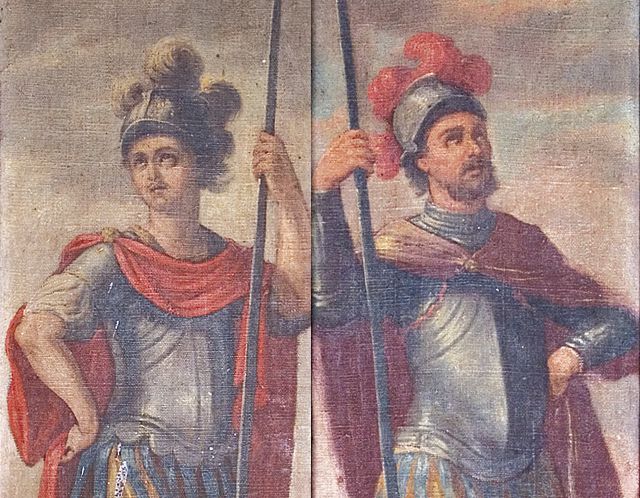 And so he did it, once the fortress fell, the two soldiers were roasted to death over the embers of a grill. Pope Honorious IV threatened the king of Aragon with excommunication for his cruelty and attending to his redemption plea, forced him to return the Kingdom of Mallorca to his original owner, his uncle. After all, the kingdom was returned to Jaume II years later by the son of Alfons of Aragon.
And so he did it, once the fortress fell, the two soldiers were roasted to death over the embers of a grill. Pope Honorious IV threatened the king of Aragon with excommunication for his cruelty and attending to his redemption plea, forced him to return the Kingdom of Mallorca to his original owner, his uncle. After all, the kingdom was returned to Jaume II years later by the son of Alfons of Aragon.
The detailed story about the two heroes is not completely known, but what is for sure, is that they were not just simple soldiers under the orders of the castle keeper but influent supporters of Jaume II of Mallorca. In the Cathedral of Palma -popularly known as la Seu- a retable in honour to the Blessed Virgin Mary and All Saints was built, among which Cabrit and Bassa were counted as martyred saints. The following Sunday to All Saints, this event was commemorated with a mass in la Seu. In the chapel of Nuestra Señora de la Piedad, martyrs' relics are conserved, except for two of their ribs that were taken to the Oratory of the Verge del Refugi of the Castell d'Alaró, where they can be contemplated in a niche. Until well entered the 17th century, Mallorcan people venerated Cabrit and Bassa as honor archetypes for maintaining their loyalty to the oath they had given until their last breath and also in a religious sense, as saints.
Middle Age and dark centuries in Alaró
Years following the island's conquest were centered on the development of the main activity of the town: agriculture. Diversification of the primary sector maintained the economic activity of Alaró people during centuries. Among the occupations of the period, we found the specialized traginers -those that transported and sold the oil produced in different farmhouses-, the carboners -those who produced coal from holm oak wood-, calciners - the ones in charge of the lime furnace- or margers – outstanding occupation in mountain areas where builders applied the technique of dry-stone walling. An important manufacture in Alaró was silk elaboration, which involved planting white mulberry tree -sustenance for the silkworms that produced the raw material.
The original church of the town was first sited in the neighborhood of Los Damunt, probably near to the place occupied now by the houses of Sa Bastida. The building of a new parish church in the mid 14th century was the seed of Alaró's modern center: the neighborhood of Los Davall that started to develop following the water-course of Ses Artigues fountain. This new neighborhood continues separated from the neighborhood of Los Damunt by Na Marranxa torrent. Los Davall then became the most dynamic place of Alaró, centralizing the urban and economic progress during the following centuries.
The excellent production of olive oil during those years was a powerful exchange coin with the rest of the island, mainly with Palma. Oil mills -Mallorcan tafones- have been a very significative agricultural industry for Alaro. In 1871, archduke Ludwig Salvator -archiduc Lluís Salvador- pointed Alaró as the third producer of this precious liquid after Soller and Lloseta.
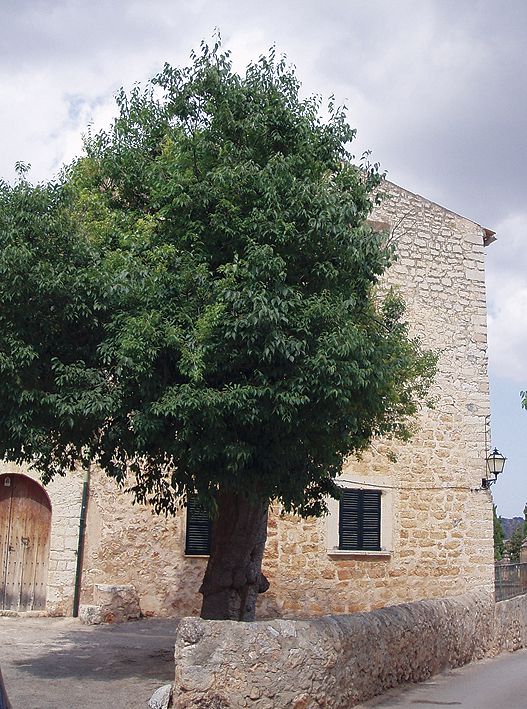
Sant Roc
The 17th was a hardship century in the island, notably affected by the plague. This epidemic affected all Mallorca in 1652 and enraged cruelly in Alaró, causing 360 deaths. This tragedy produced a great devotion for Sant Roc, a lawyer against the plague that was dedicated numerous prayers and was believed to have ended with the epidemic. Proclaimed patron of the town since 1771, every 16th of August its festivity is celebrated.
During those centuries, the importance of Castell d'Alaró as a defensive fortress decayed and gradually, being intensely used as a pious place, it evolved into a sanctuary. Its military preservation disappeared almost completely in this period. An hermit use was also given to Alaro Castle around the mid 17th century: Joan Mir Vallès, originally from Alaró, lived in the Castle for some years devoted to meditation, preserving and protecting the little chapel as part of his spiritual retirement and Christian devotion, but when its religious use and popularity increased he preferred to retire to Valldemossa.
From this period -late 17th century-, dates the building of the Oratory of the Virgin of the Refuge -Verge del Refugi- and of a Via Crucis that accompanied the Catholic on their pilgrimages to the fortress.
Alaró, town of pioneers: modernity and innovation
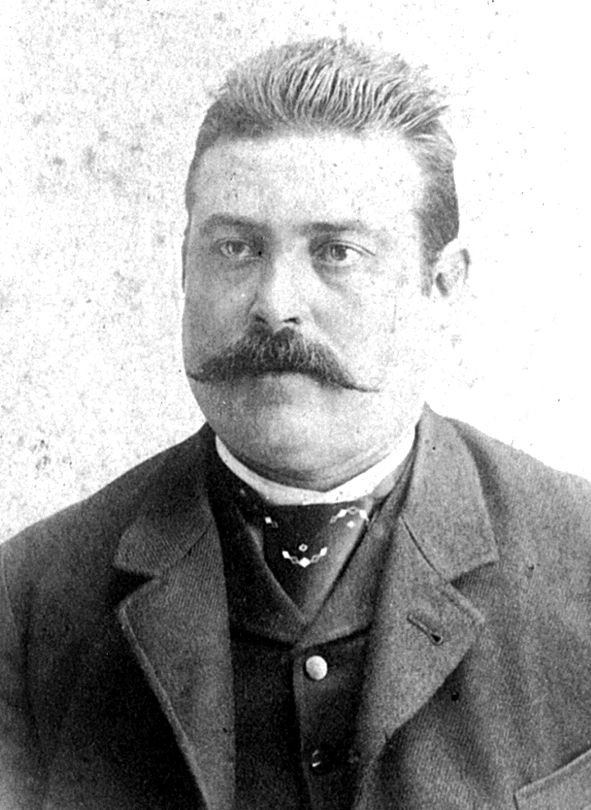
At the end of the 19th century, the town initiated an unstoppable process of industrialization and innovation. Alaró people were pioneers in manufacturing progress, which added to their enterprising spirit, led them to be the first town in Mallorca with electric light, to set up the first cinema hall, or, more recently, to be precursors of local televisions.
Also, an industry stood out rapidly in town: shoe industry started to replace agriculture as the main occupation of the people. This circumstance, joined to the recession of olive oil commercialization in the 19th century, was translated into a decrease of olive groves and use of olive mills. To the prosperous development of shoe industry, lignite mines added to the economic engine of the town. In 1881, the first railway line between Alaró and Consell was opened.
Although the important economic revival of this years mark the evolution of Alaró, there is a fact that changed drastically the morphology and history of the town: Consell, center depending of Alaró, segregated in 1925.
Electricity arrives to Alaró
Alaró started up in 1901 the first powerhouse of Mallorca, even before than Palma. The opening supposed an outstanding process of growth and modernization that reflected positively in the social and economic areas of the village.
The Electricity Company of Alaró was promoted by brothers Gaspar and Josep Perelló Pol. In a trip to Barcelona, Gaspar Perelló visited a powerhouse, where he was provided with the machinery plans. Once in Alaró, the two brothers installed a powerhouse of similar characteristics. The invention worked as a power station moved by a 100 horse power steam machine that produced electricity. The inauguration was made the first of August of 1901, becoming a grand social event with numerous visitors from other towns as from Ciutat -popular name of the capital of the island-, from where special trains were set out for the event.
Chronicles of the period narrated it like this:Cornmuses and tambourins were musically present, Cossiers danced at the church offertory and in the machine room. Later at night, when the town was enlightened, a multitudinous applause covered the streets of town.
In 1917, Perelló brothers sold the system with its distribution network to Consell, Binissalem and Lloseta through the company Mallorcan Electricity -Mallorquina de Electricidad. The only remain from the old powerhouse was rehabilitated in 2001 to celebrate the centenary of its opening.
Cinema
Perelló brothers were not happy enough with introducing electric light in Alaró, so they embarked on the adventure of bringing a cinema to the town. They started to run the first cinema hall of Mallorca in 1903 and during some time, Alaró gathered together public from every point of the island to enjoy film screens, as similar cinema halls did not open until some years later in Palma and other towns.
Shoe industry
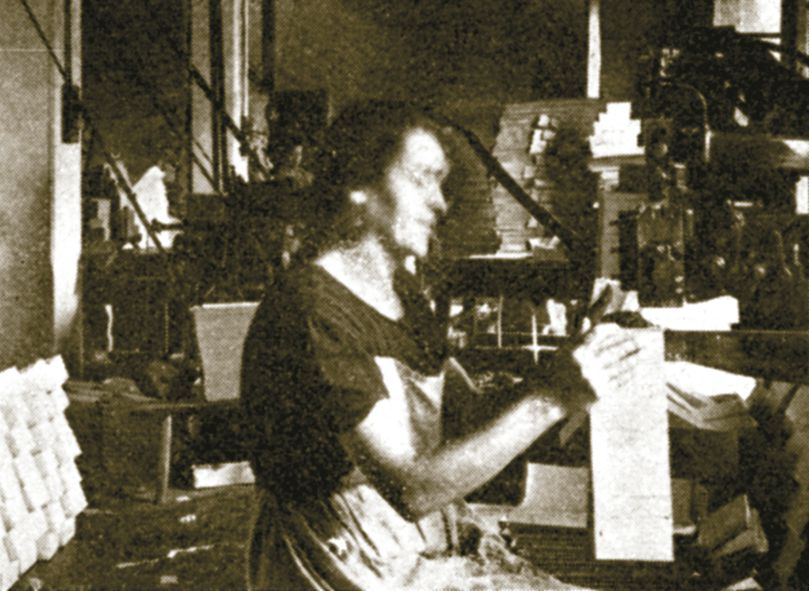
In the late 19th century, shoe manufacture initiates its course in Alaró, an industry that has pervaded until present. Jaume Pizà Jaumico opened the first shoe workshop in town and later, new factories were established progressively: Can Pau Coll, Can Joan Vidal or Can Pericàs are some of them. The first exportations were sent to America and during the First World War workshops specialized in supplying boots to the French army. In 1955, 50 shoe workshops could be counted in the village.
Other products started its commercialization thanks to the emerging shoe manufacture. Among them, two cardboard factories that were initially created for sending shoes from Alaró, ended up supplying half of the island. Even some carpenters specialized in manufacturing wood boxes for shoe transport.
Coal mines
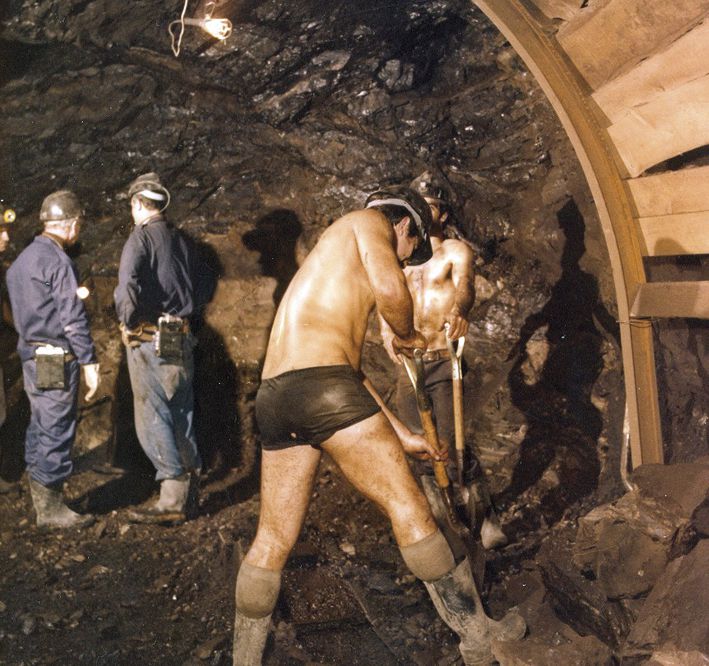
One of the main factors of the economic flourishing of Alaró was coal. During the first third of the 19th century, coal mining was initiated. In those times, archduke Ludwig Salvator -archiduc Lluís Salvador- already describes two mines, la Fortuna and la Dolores. In the mid 20th century six mines were working, which in the seventies were acquired by the National Institute of Industry. After being purchased by GESA, its use was exclusively dedicated to the consume of power stations. In 1988, the number of deposits working had decreased considerably and a year later, lignite extraction ceased due to its lack of rentability.
Local train
Pocs vestigis queden avui dia de la malaguanyada companyia del ferrocarril alaroner després del pas implacable del temps. L’ampliació i el nou traçat de la carretera de Consell-Alaró fan molt difícil apreciar l’antic traçat de la línia ferroviària.
The drawing of the line from Palma to Inca in 1875 was the starting point for the idea of having its own railway, which did not leave the town isolated from industrial progress and gave way to commercial exchange. The initiative materialized on May 22, 1881 with the inauguration of the 3.4 km railway line from Alaró, which connected with the main line linking Palma with Inca.
The lack of budget meant that the line was inaugurated with animal traction – mules pulled the load from Consell to Alaró and the return journey was made simply by gravity – but then it became an engine-driven tram. The train stopped working due to competition from road transport from the 1930s.
Republic, Civil War and the post-war years
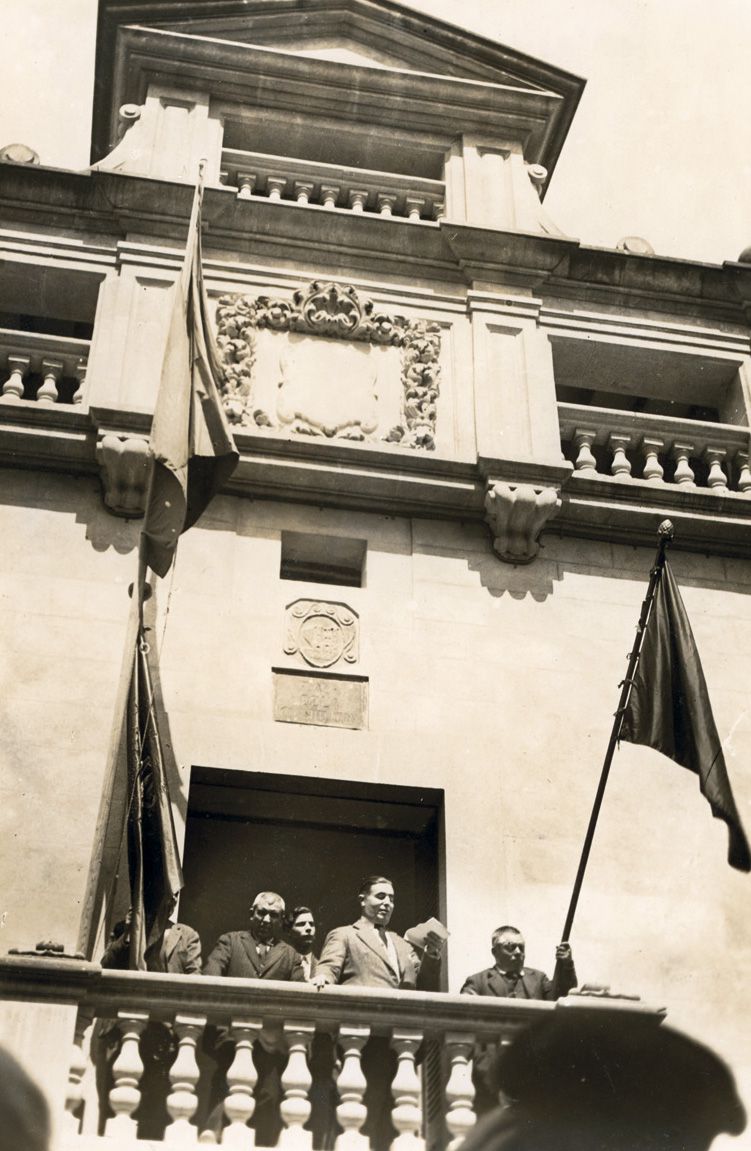
The phenomenon of globalization - or its consequences - is not exclusive to today: the end of the First World War caused a drastic decrease in the orders that arrived in Alaró for military boots, a fact which the industry resented of local footwear and which forced some artisans to emigrate to France and Argentina.
The years prior to the declaration of the Second Republic in 1931 were crucial in the incipient social movements and worker associationism, the seed and driver of the events that followed. In the years of the republic, Alaró worked intensively on education, and this translated into cultural services such as the opening of the library, education for adults and the star action: the construction of the new school , which is still in use.
The widespread uprisings of October 1934 did not occur in Alaró, but arrests were made and the left-wing council was dismissed. The coup d'état following the 1936 elections gave way to the darkest years in Spanish history. For Alaró, as in the rest of Spain, the Civil War was one of the saddest events in the town's history.
Alaró current
After the post-war years, Alaró recovered strong industrial and mining activity and, from the sixties, it ceased to be a focus of emigration to become one of immigration.
In the 1980s, the excessive dependence on exports to the United States and the loss of competitiveness in this market caused the beginning of a crisis in the footwear sector that ended with the practical disappearance of factories. Today, only a few companies linked to the footwear industry survive, such as the Tony Mora company or the corporate headquarters of the well-known Camper brand, the leading exponent of Spanish footwear at an international level.
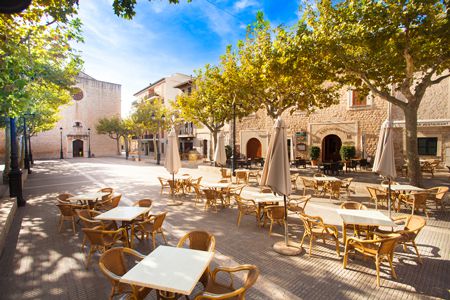
Alaró has ceased to be a town with a marked industrial fabric - like most of the municipalities in Mallorca that at some point were - and has become a quiet residential town but with moderate commercial and tourist activity thanks to its privileged geographical location and a lively social life.